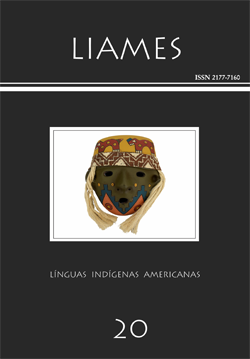Abstract
The ethnological matters dealt with in this paper are concerned with three North Carib groups ---Kari’ña, Pemon and Ye’kwana--- all of them settled within Venezuelan boundaries. The aim has been to index those lexical items representing “motifs” (Motif-Index of Folk-Literature, Stith Thompson, 1950-1955) within oral tales by means of which traditions are passed on from a generation to the following one. Thompson (1946) defines “motif” as “[…] the smallest element in a tale having a power to persist in tradition. In order to have this power it must have something unusual and striking about it” (pág. 415). The compiled motif-index, or MI, comes from 8 tales, labeled as text-files 1 though 8: 2 of them elicited by Kari’ña natives, 2 by Pemon ones, and 4 more by Ye’kwana ones; a total of 31 motifs were indexed within these 8 text-files. The motifs identify human and non-human entities with fantastic physical and behavior traits. As well, the MI includes motifs referring activities performed by the above-mentioned kind of entites, for which especial attitudes and instruments are required. Along the paper, each motifs indexed is presented to the reader both in context and in a separate matrix in which every descriptor fits within the type(s) and subtype(s) set up by Thompson (1955-1958); Valory (1967); and Wilbert (1979, 1975). The tales analyzed were collected in the native languages by the author, and they were transcribed by him as part of his researches about the Kari’ña, Pemon and Ye’kwana morphosyntax. Nonetheless, for this paper, the author used segments previously translated into Spanish by Civrieux (1970, 1976); Armellada and Bentivenga (1980); Guevara (2011); Armellada (1973); and Arreaza Adam (2005). The final MI supplied the data for an additional attempt to characterize ethnoculturally these northern Carib peoples. .
References
Armellada, Césareo de (1973). Taurón pantón II. Caracas: Universidad Católica Andrés Bello.
Armellada, Césareo de y C. Bentivenga (1980). Literatura indígena venezolana. Caracas: Monte Ávila Editores.
Armellada, Césareo de y M. Gutierrez (1981). Diccionario pemón. Caracas: Publicaciones Corpoven.
Arreaza Adam, Henrietta (2005). Watunna. La canción del mundo. Cosmogonía ye’kwana. Mérida, Venezuela: Siembraviva Ediciones.
Civrieux, Marc de (1970). Watunna: mitología maquiritare. Caracas: Monte Ávila Editores.
Civrieux, Marc de (1976). Los caribes y la conquista de la Guyana española (Etnohistoria kari'ña). Caracas: UCAB.
Ferro, Roberto (20 de julio 2014). Pueblo kari’ña --- Textos y fotos [Mensaje en un blog].
http: //textosyfotos.blogspot.com>2014/07>pueblo-karina.html
Guevara, José (2011). La identidad cero (La dinastía cero). https://books.google.co.ve/books?id=XmXvAgAAQBAJ&dq=La+identidad+cero+por+Jos%C3%A9+A.+Guevara&source=gbs_navlinks_s
Honti, János (1937). A Mese világa. Budapest: Pantheon.
Instituto Nacional de Estadística (INE)-Venezuela (2011). XIV Censo Nacional de Población y Vivienda. http://www.ine.gov.ve/CENSO2011/
Romero-Figueroa, Andrés (2011). El sistema ergativo de las caribes del norte, ¿muestra signos de debilitamiento? En Andrés Romero-Figueroa (coord.), Lenguas indígenas de América: morfología y sintaxis, pp. 116-140. Caracas: Universidad Católica Andrés Bello.
Romero-Figueroa, Andrés (2013a). Deixis y anáfora en pemón, ye’kwana y panare (caribes del norte). En Ana Fernández; Marisa Censabella; y Marisa Malvestitti (eds.), Lingüística Amerindia: Contribuciones y perspectivas, pp. 115-126. Buenos Aires: Universidad de Buenos Aires.
Romero-Figueroa, Andrés (2013b). El originario sistema de patrones ergativo de las lenguas caribes del norte. UniverSOS 10: 11-34. https://dialnet.unirioja.es/servlet/revista?codigo=8164
Romero-Figueroa, Andrés (2013c). Análisis tipológico funcional de los comparativos en las lenguas caribes del norte. Boletín de Lingüística UCV 25(39-40): 187-216. https://dialnet.unirioja.es/servlet/articulo?codigo=4557150
Romero-Figueroa, Andrés (2015). Cláusulas ergativas y no ergativas en ye’kwana (caribe del norte). LIAMES – Línguas Indígenas Americanas 15(1): 113-124. https://doi.org/10.20396/liames.v15i1.8641498
Thompson, Stith (1977 [1946]). The folktale. New York: Holt, Rinehart and Winston.
Thompson, Stith (1955-1958). Motif-Index of folk literature. Bloomington: Indiana University Press.
Valory, Dale (1967). Folklore of the Fuego-Patagonian peoples: Annotated bibliography. Behavior Sciences Notes 2(3): 175-202.
Wilbert, Johannes (1970). Folk literature of the Warao Indians: Narrative material and Motif Content. Los Angeles: University of California, Latin American Center Publications.
Wilbert, Johannes (1975). Folk-Literature of the Selknam Indians. Los Angeles: University of California, Latin American Center Publications.
The LIAMES: Línguas Indígenas Americanas uses the Creative Commons license (CC), thus preserving the integrity of the articles in an open access environment.



